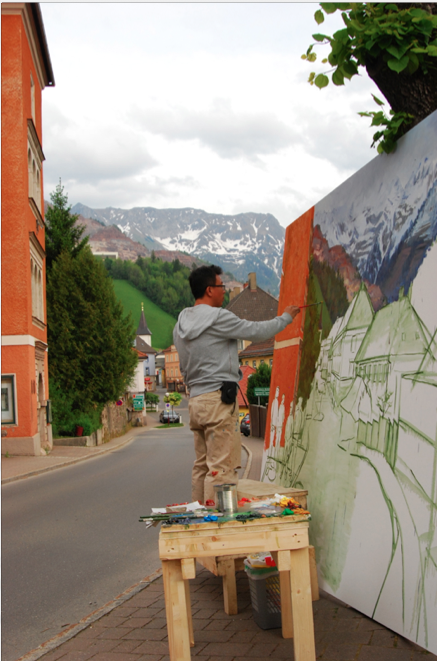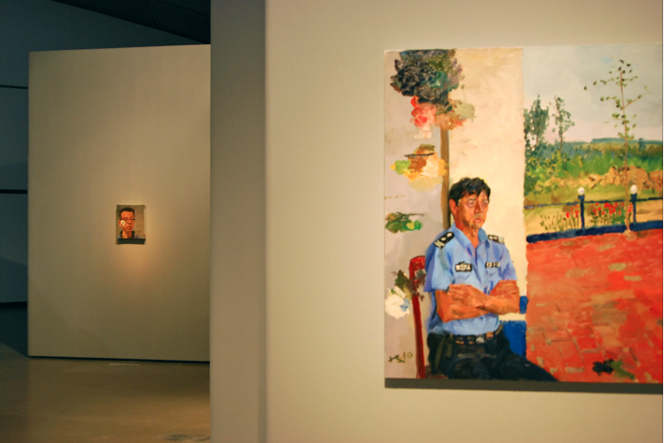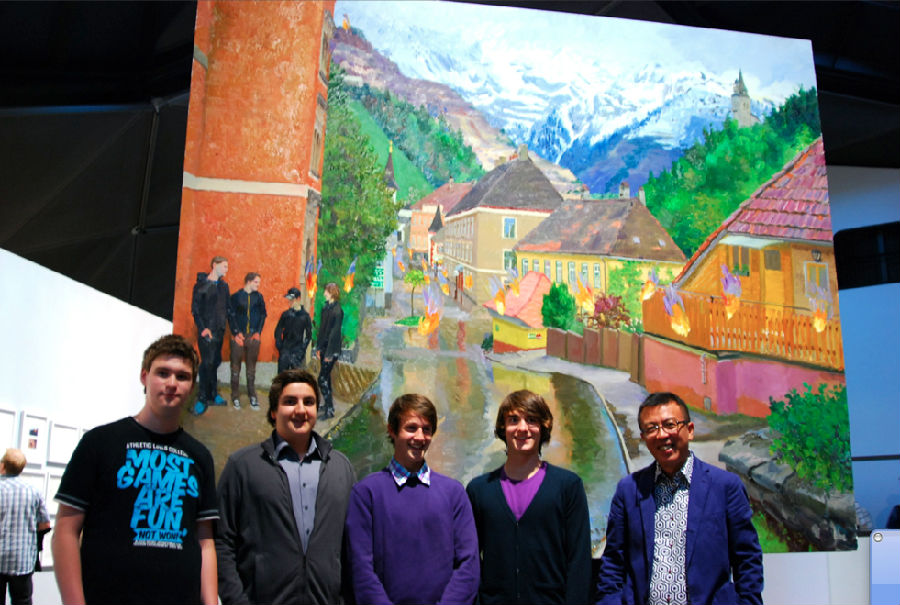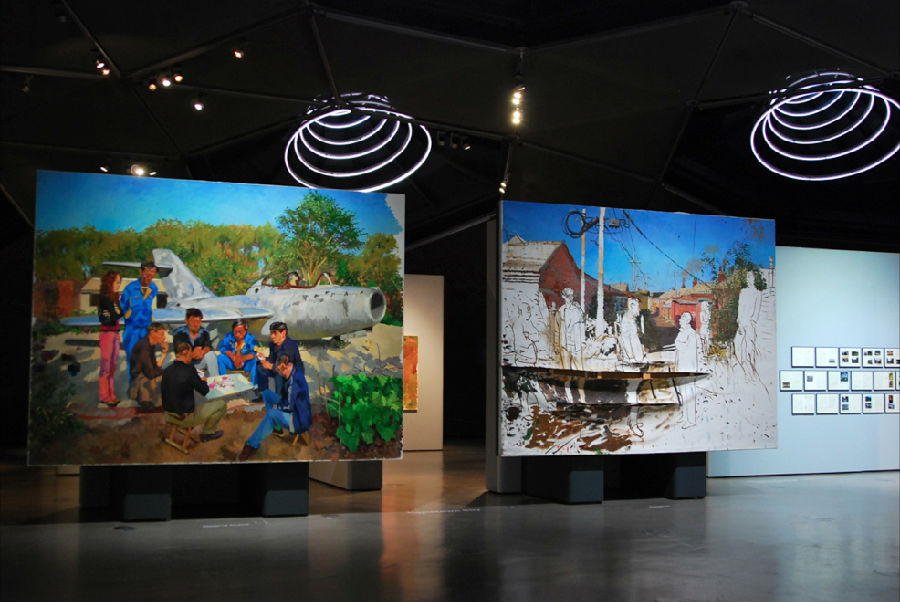
Liu Xiaodong
The Process of Painting
Kunsthaus Graz, Space01, Lendkai 1, 8020 Graz
Opening: 05.06.2012, 7pm
Duration: 06.06.-02.09.2012
Curator: Günther Holler-Schuster
Information: +43-316/8017-9200, kunsthausgraz@museum-joanneum.at
The painter Liu Xiaodong is one of the most well-known representatives internationally of ageneration of Chinese artists, who grew up in a new society marked by rapid and frequent shiftsin perspective. These artists were forced to turn away from the idealism and heroism of thepreceding generation, or at least to reinterpret it. No longer were their efforts directed towardsglorifying the system or conversely resisting recklessly state powers; they were shaped by theneed to find their bearings within a profoundly felt powerlessness. Liu Xiaodong was educated inclassical oil painting, and in terms of form has not left behind the painting tradition thatemerged from Socialist Realism. Yet he has changed the content drastically, lending a voice todaily life against a background of sweeping changes. Earthquakes, changes in landscape andhuman-made ecological disasters as well as social formation based on economic transformation:all this has been captured by Liu Xiaodong. China has become synonymous world-wide with far-reaching movements and upheavals of this kind. The Yangtse Kiang Three Gorges Dam is onlyone of the many examples of how the life of those affected has been completely reconfigured,creating massive transformation in their existence within a short time.
Liu confronts the developments by visiting the places concerned, setting up with a team ofassistants and a camera crew in situ, and attempting to capture the significance of events invisual form. Painting thereby turns into a medium of documentation and interpretation. Theprocedural and dramatic aspects of painting are emphasised by the multimedia approach. Thepainting takes as its theme the decision of the singly captured extract, while the film can pindown procedures. Both are calculated to enable narrative flow as well as objectivedocumentation. For example, Hometown Boy describes developments in his own home town ofJincheng – a small city in China’s north-eastern province of Liaoning – which been shaped by thepaper industry. Everyday life, individual fates, and the alienation experienced by people in thecontext of social processes – all this is captured by Liu over a period of two months. In theprocess, large-format paintings are created, photo and sketch tableaux akin to a diary, as well asa film directed by Hou Hsiao-Hsien, one of Taiwan’s most prominent directors.
For the exhibition in the Kunsthaus Graz, the artist has chosen Eisenerz in Upper Styria as thelocation for his latest project. The situation with the centuries-old industrial and culturallandscape bears a striking resemblance with conditions in China. Eisenerz, exposed to anenormous process of change, is suddenly transformed into a global model. The degenerationcaused by structural shifts and the accompanying social transformation have created clearlyvisible problems; attempts to overcome them are varied. As a painter Liu does not tackle eventsand historical developments in a combative way, rather as a chronicler. In the history of painting,Eisenerz, as a powerful, identity-creating location, was often the subject of art. Mostly idealised,the place or its setting was shown as a success story, with iron ore itself mystified as the life-giving foundation of human existence.
Liu Xiaodong will live and work for a month in Eisenerz too, with a team of assistants andcamera operators. His artistic practice at this moment is no longer a phenomenon to beunderstood purely in the Chinese context. Rather he is achieving general validity in this work. Asa painter, he does not create the illusion of being able to turn wrongs into something better.But, like other painters too, he does try to overcome the sheer massiveness of the themes andproblems in painting.
Besides the paintings, films by the artist will also be shown in the exhibition. His latest film, LiuXiaodong in Eisenerz, takes as its theme painting as a process, showing that there isincomparably more information in a picture beyond the painting per se. The film Hometown Boy,rather a feature film in character, thematises the period that Liu spent in his former home city,with his family and friends from his childhood and teenage years. Of interest are the parallelsbetween both places: Liu’s home city was once a growing industrial city that lived from thepaper industry, and like Eisenerz was hard hit by a rapid decline in the industry. In the finalanalysis the film, like Liu Xiaodong’s painting, is an attempt to add humanity to a society devoidof it – not only in China.
His roots from one of the most traditional branches of painting – Socialist Realism – suddenlyacquire a completely different meaning: political programmatic images of any kind have losttheir force; social utopias no longer seem to have any permanence. It is the end of the utopia ofa world renewal brought about by reforms and revolutions. The linking of the most varied, oftenalso contradictory ideological approaches makes the enemy ever harder to pin down. Based onthe powerlessness of the painter in view of the ever-faster, and in its effect ever more powerfulbecoming developments, Liu attempts to express the transition from one form of society to theother through pictures, appealing to the power of images, which especially these days are muchquoted. Liu Xiaodong’s project The Process of Painting is a path that painting today can tread,both in terms of form and contents, without losing the relevance that these days it is so oftensaid no longer to possess.
Text: Günther Holler-Schuster
All images Courtesy of Zandie Brockett







